Nearly every car company in the world is planning on releasing at least one electric car in the coming years. Once stuck in a niche, battery-powered vehicles are about to become a lot more common on American roads.
- Audi E-Tron GT
- Audi Q4 E-Tron
- Aston Martin Lagonda
- BMW i4
- BMW i7
- BMW iNext
- Bollinger B1
- Byton M-Byte
- Cadillac Celestiq
- Cadillac Lyriq
- Chevrolet Bolt-based crossover
- Faraday Future FF91
- Fisker Ocean
- Ford F-150 Electric
- Ford Mustang Mach-E
- GMC Hummer
- Honda EVs
- Kia Soul EV
- Lordstown Endurance
- Lotus Evija
- Lucid Air
- Maserati GranTurismo
- Maserati MC20
- Mercedes-Benz EQA
- Mercedes-Benz EQC
- Mercedes-Benz EQS
- Nissan Ariya
- Pininfarina Battista
- Pininfarina Pura Vision
- Polestar 2
- Polestar 3
- Porsche Macan
- Porsche Taycan Cross Turismo
- Rimac C_Two
- Rivian R1T
- Rivian R1S
- Subaru EV
- Tesla city car
- Tesla Cybertruck
- Tesla Model S Plaid
- Tesla Roadster
- Volkswagen ID.4
- Volkswagen ID.Buggy
- Volkswagen ID.Buzz
- Volvo XC40 Recharge
Further reading
We’ve put together a comprehensive list of the electric cars expected to arrive in showrooms in the near future. Keep in mind that we’re only including cars that have been officially announced and models that we’re confident are in the pipeline. We’ve largely ignored the countless unverifiable rumors swirling around the internet, and we’ve left out models developed exclusively for overseas markets, like the Honda E and the Volkswagen ID.3.
Audi E-Tron GT

Base range: TBD
Base price: TBD
Available in: 2021
We’ve often heard rumors outlining an electric Audi Sport model developed with a focus on performance — this is it. The E-Tron GT concept introduced at the 2018 Los Angeles Auto Show will reach production with only minor changes. “We have never done a show car as close to series production as this,” Enzo Rothfuss, Audi’s head of interior design, told Digital Trends ahead of the car’s unveiling. What you see is pretty much what you’ll get.
The stylish sheet metal hides a basic architecture shared with the Porsche Taycan, so it’s built on proven bones. The GT’s two electric motors join forces to deliver 590 horsepower and send it from zero to 60mph in 3.5 seconds. It will be worthy of joining the Audi Sport range, in other words. Look for it in showrooms in 2021.
Audi Q4 E-Tron

Base range: TBD
Base price: TBD
Available in: 2021
Some concept cars are built to explore what we’ll drive in 50 years, but the Audi Q4 E-Tron is not one of them. It’s already well on its way to production. It will slot at the bottom of the company’s growing electric car lineup, and it will look close to the design study shown above. The concept offers 301 hp from a pair of electric motors wired to an 82-kilowatt-hour lithium-ion battery pack. This configuration could reach showrooms, but the range will also include a more accessible rear-wheel drive model powered by a single motor.
Aston Martin Lagonda

Base range: TBD
Base price: TBD
Available in: 2025
The third Aston Martin sedan to wear the Lagonda nameplate will break all ties with tradition. It will be less boxy than its predecessors, and it will exist at the unlikely intersection of sedans, crossovers, and vans. We don’t know how much of the concept’s design will change as it pivots toward production. Aston Martin hasn’t said much about it because it’s currently focused on ramping up production of the DBX, its first entry into the SUV segment.
The British firm hopes to build up Lagonda as a sub-brand aimed at Rolls-Royce and Bentley; that means luxury first, performance second. The sedan shown above will be joined by a crossover, but neither will arrive until the second half of the 2020s. Aston Martin is standing on shaky financial footing, so it delayed both to focus on more profitable sports cars.
BMW i4

Base range: TBD
Base price: TBD
Available in: 2021
The BMW i4 is an electric sedan that’s about the same size as the 3 Series. This positioning is crucial because it puts the model in the same arena as the Tesla Model 3. It’s not expected to arrive until 2021, but BMW already revealed the model will pack a 530 hp powertrain made up of two motors, and it will store enough electricity to drive for more than 300 miles between charges. The i4 concept shown above sheds light on what the model will look like.
BMW announced the i4 will spawn a sports sedan developed by its M division before the end of 2021.
BMW i7

Base range: TBD
Base price: TBD
Available in: TBD
BMW confirmed the next-generation 7 Series will be available with four powertrain types: Gasoline, diesel, hybrid, and electric. The electric, which will be joining the range for the first time, will stand out as the most powerful member of the range. It will use the same powertrain technology as the i4, among other electric BMW models. We wouldn’t be surprised if it arrives with the i7 nameplate, but nothing is official at this point — not even its release date.
BMW iNext

Base range: TBD
Base price: TBD
Available in: 2021
This battery-powered SUV is shaping up to be one of the most advanced cars BMW has ever released. It will be the firm’s first 5G-compatible model, thanks to a partnership with Samsung, it will offer a comprehensive suite of semi-autonomous driving aids; and its cutting-edge infotainment system will be displayed on a wide, curved touchscreen oriented toward the driver. BMW went as far as reinventing the steering wheel to make the shift between semi-autonomous and human driving as seamless as possible. Production is scheduled to start in the summer of 2021.
Bollinger B1

Base range: 200 miles
Base price: $125,000
Available in: 2020
New York-based Bollinger wants to develop the toughest electric trucks on the market. Sure, you can take them camping, but they’re just as happy to slog through the woods or work construction. The young company plans to enter the market with an SUV named B1 and a pickup truck called B2, both built using the same powertrain parts.
They’ll offer 614 hp, they’ll be capable of driving through 36 inches of water, and they’ll have a 7,500-pound towing capacity. Bollinger left out airbags, power windows, and other features most motorists consider crucial to make its trucks as simple as possible. Since they don’t have an engine, there’s a huge pass-through that stretches from bumper to bumper, so users won’t need to worry about strapping lumber or a ladder to the roof.
Byton M-Byte

Base range: TBD
Base price: TBD
Available in: 2021
China’s Byton developed the M-Byte, its first car, to revolutionize in-car technology. Its claim to fame is a television-like, 48-inch, high-resolution screen that fills the space directly below the windshield. Users will have the ability to configure the software in a variety of different ways, much like a smartphone or a laptop, and Byton invited developers to create apps for it. There’s also a screen integrated directly into the steering wheel and one on the center console. We’ll have a better idea of whether this layout is useful or if it’s a tech overload when the first examples hit the road in 2021. The company plans to release a sedan named K-Byte shortly after.
Will it survive long enough to produce either car? There’s been a major toll on its operations, according to The Detroit Bureau, and it announced plans to furlough nearly its entire staff around the world in June 2020. It’s currently looking for a way forward.
Cadillac Celestiq

Base range: TBD
Base price: TBD
Available in: TBD
Cadillac is preparing an electric flagship sedan that will become one of the most expensive cars ever built by General Motors. We haven’t seen it yet (the image above shows the CT6, the brand’s former range-topping model), but we hear it has an extra-long wheelbase, 23-inch wheels, and cameras in lieu of mirrors. Visually, it will borrow a handful of styling cues from the Lyriq described below. Cadillac hinted that the model will be hand-built in extremely limited quantities, so its reasonable to assume it will get a six-digit price.
Cadillac Lyriq

Base range: TBD
Base price: TBD
Available in: 2021
General Motors gave Cadillac the honor of being the first brand to build a car on the BEV3 architecture it’s developing to underpin a wide range of electric models. There’s much more than sheet metal, quick-thinking computers, and pounds of wiring riding on it: It’s the toolkit executives are betting on to accelerate the company’s electric car offensive.
“The BEV3 platform is the canvas upon which we’ll paint a profitable EV program,” General Motors president Mark Reuss affirmed during a media event in 2019. What that means for Cadillac, and how it will shape its yet-unnamed electric crossover, remains to be seen. The model is scheduled to make its debut online on August 6, 2020, though it likely won’t be available until 2021 at the earliest.
When it lands, the Lyriq will offer a 34-inch OLED screen for the infotainment system, it will ride on 22-inch wheels, and it’s expected to boast at least 300 miles of driving range. It will be positioned near the very top of the Cadillac range.
Chevrolet Bolt-based crossover
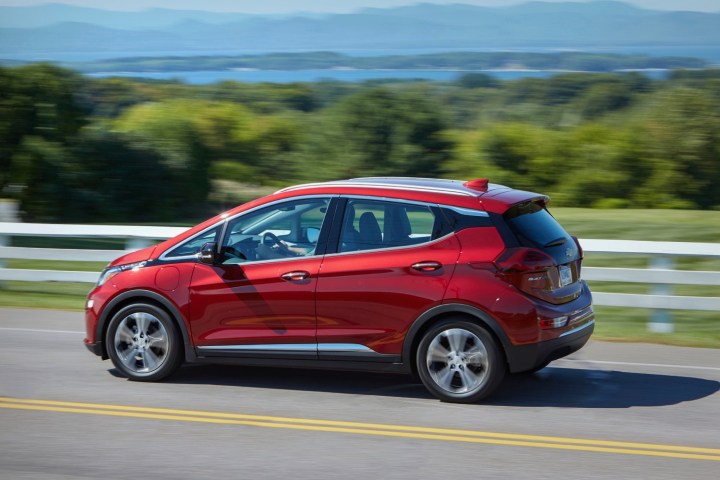
Base range: TBD
Base price: TBD
Available in: 2022
Chevrolet is planning a crossover-like variant of the Bolt (shown above), which already blurs the line between hatchbacks and SUVs. Confused? So are we, but we should learn more about the model in the coming months. It will be built on the same basic architecture as the Bolt, so it will offer at least 250 miles of range, and it will be one of the more affordable models in its segment. It won’t arrive as a high-end, supercar-quick electric car with a price tag to match. Chevrolet will also launch a bigger electric crossover in the 2020s.
Faraday Future FF91
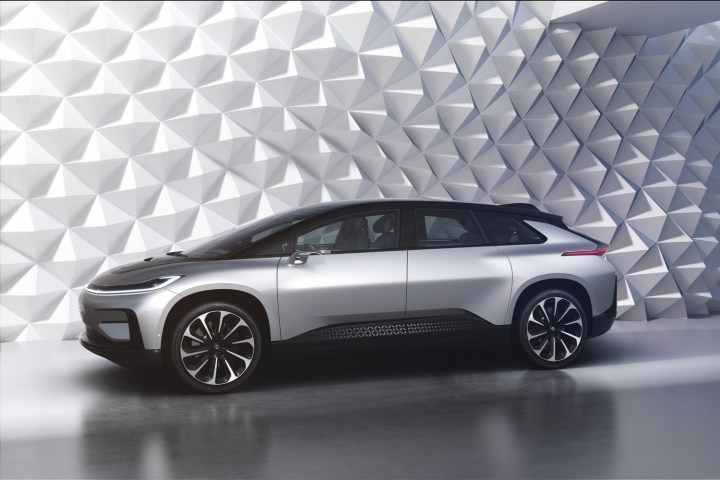
Base range: 400 miles
Base price: $120,000
Available in: 2020
The Faraday Future FF91’s path to production has been rocky and convoluted, but it’s far closer than it might seem. Digital Trends got the opportunity to take one for a quick spin during CES 2020, and we had to pick up our jaw from its footwell before stepping out. It feels like no other car we’ve been in. Its electric powertrain offers more than 1,000 hp and its dashboard has a unique layout that emphasizes roominess. Owners who get tired of its 2.3-second zero-to-60mph time can relax in the business class-like seats out back.
FF91 production will start in California by the end of 2020. The firm plans to expand its range with smaller models, including an FF81 and an FF71, in the coming years.
Fisker Ocean

Base range: 250
Base price: $37,499
Available in: 2021
After launching the Fisker Karma, automotive designer Henrik Fisker created a new automaker named after himself and unveiled what will be its first model at CES 2020. The Ocean is a crossover that stands out with a futuristic design, a vegan interior, and what the company calls California Mode, which allows the breeze in by lowering every window — even the ones in the quarter panels, which we’re told was a packaging nightmare.
The Ocean is built on an 80 kWh lithium-ion battery pack that will deliver between 250 and 300 miles of range depending on the configuration. The solar panel on its roof can add up to 1,000 miles of driving range annually, assuming it’s parked in the sun regularly, which is a neat technology Fisker hopes to improve over time.
Fisker realizes it likely can’t survive by selling a single model, however. The Ocean’s basic platform will underpin additional cars during the 2020s, and the EMotion remains on track for production.
Ford F-150 Electric

Base range: TBD
Base price: TBD
Available in: 2022
America’s best-selling vehicle for decades is going electric. Ford confirmed it will offer a battery-powered version of the next-gen F-150 to fend off an offensive led by Tesla and Rivian. Little is known about the model, though we know it will be the quickest and most powerful version of the truck, and deliveries are tentatively scheduled to start in 2022. If you can’t wait that long for an electrified truck, you’ll have to settle for the PowerBoost hybrid model introduced in June 2020. Its gasoline-electric drivetrain is built around a 3.5-liter EcoBoost V6 engine.
Ford Mustang Mach-E

Base range: 230 miles
Base price: $43,895
Available in: 2020
Assigning the Mustang nameplate to an electric crossover is a contentious move, but Ford argues the model is worthy of this hallowed name. Designed with performance in mind, the Mustang Mach-E shares nothing with the two-door Mustang currently on the market; it’s new from the ground up. It stands out with a muscular design that looks even better in person, several powertrain options, and impressive in-car tech. On paper, that’s enough to give the Tesla Model Y a run for its money, and the fact that one version is already sold out suggests motorists agree.
GMC Hummer

Base range: TBD
Base price: TBD
Available in: 2021
The formerly gas-guzzling Hummer will make an electrifying comeback in 2021. General Motors will resurrect the name on an electric, GMC-badged pickup truck that will offer up to 1,000 hp in its most potent configuration. It will be manufactured in Detroit, and a dark teaser image confirms its design will pick up where models like the H2 and the H3 left off, but we don’t know much else about it. We expect to find out more in the coming months. It will make its debut as a pickup, but the range will grow to include an SUV, too.
Honda EVs

Base range: TBD
Base price: TBD
Available in: 2024
Honda’s first purpose-designed electric car, the E (shown above), isn’t available in the United States. Instead of bringing it here, the Japanese company will borrow battery and powertrain technology from General Motors to develop two EVs specifically for the American market. It’s reasonable to assume at least one will be an SUV, but details remain murky at best. Sales will begin for the 2024 model year, meaning we’ll likely see the first model in 2023, and both will be manufactured by General Motors.
Kia Soul EV

Base range: TBD
Base price: TBD
Available in: 2021
While the third-gen Soul is available in showrooms nationwide, Kia delayed the electric version’s American launch to send the bulk of the production run to the European market, where companies who don’t comply with strict emissions regulations risk massive fines. Details about the American-spec model haven’t been released yet.
For context, the Soul EV sold in Europe comes with a 64 kWh lithium-ion battery pack that spins a 201 hp electric motor, and it offers approximately 280 miles of range. The latter figure will be adjusted down for our market when the hatchback makes its debut. It was originally scheduled to arrive in the U.S. during the 2020 model year, but Kia announced we shouldn’t expect to see it until the 2021 calendar year at the earliest.
Lordstown Endurance

Base range: 250 miles
Base price: $52,500
Available in: 2021
Lordstown gets its name from Lordstown, Ohio, the town it plans to build electric pickup trucks in. Called Endurance, its first model is being developed using technology sourced from another startup named Workhorse. The specifications sheet lists four electric motors (one per wheel), 250 miles of range, 600 hp, and a $52,500 base price before incentives enter the equation.
That’s a tall order to fill, and the firm ambitiously plans to beat Ford, General Motors, Rivian, and Tesla to the market by striking first. It plans to begin delivering the Endurance in 2021. There’s a catch: Although you’ll theoretically be able to drive the Endurance in 2021, Lordstown stressed the truck is aimed at fleet operators, not private buyers. It’s not too far-fetched to speculate the company will sell trucks to private buyers sooner or later, especially as it expands its lineup, but it’s too early to tell when that will happen.
Lotus Evija

Base range: 250 miles
Base price: $2.5 million (estimate)
Available in: 2020
Lotus made a name for itself by designing roadsters that are as nimble on back roads as on the track. The Evija is a completely different kind of sports car, though. It’s bigger and heavier than an Evora, and it ditches the mid-engined configuration for a 2,000 hp electric powertrain (seriously) that puts a motor behind each wheel. Carbon fiber helps offset the weight added by the battery pack, but the Evija weighs about 3,700 pounds.
With colossal power comes a colossal price. The first electric Lotus costs between 1.5 and 2.5 million British pounds (about $1.9 and $3.2 million), and production is limited to 130 examples. The first year’s production is sold out.
Lucid Air

Base range: TBD
Base price: TBD
Available in: 2021
Backed by Saudi Arabia’s sovereign wealth fund, Lucid is one of the quieter startups in the automotive industry. It hasn’t made bold claims about dethroning Tesla, though it’s developing a high-performance car, and it hasn’t promised to pelt the gasoline-powered engine into the pantheon of automotive history, yet the Air sedan it announced in 2016 is nearly ready to enter production. Introduced online in September 2020, it offers a monstrous 1,080 horsepower and 517 miles of driving range in its most powerful configuration. Cheaper, less powerful variants with less range will join the lineup a little bit later in the production run, the company confirmed.
Production will take place in a new factory located in Casa Grande, Arizona. Motorists can reserve an early build slot by sending the company a refundable $1,000 deposit.
Maserati GranTurismo

Base range: TBD
Base price: TBD
Available in: TBD
Maserati confirmed the next GranTurismo (current-generation model pictured) will be its first electric model. Power will come from a three-motor drivetrain called Folgore (which means “lightning” in Italian) that the firm developed in-house. It will consist of two electric motors in the back — one for each wheel — and one mounted over the front axle. Additional details about the coupe and the technology packed in it will emerge in 2020.
Maserati MC20

Base range: TBD
Base price: TBD
Available in: TBD
Celebrated as the first new Maserati of the 2020s, the MC20 is a two-seater sports car powered by a powerful, mid-mounted V6 engine. What’s it doing here, then? Well, the Italian company confirmed it will release an electric version of its halo model in 2022 at the earliest. It will be closely related to the gasoline-powered model, though minor visual details will set the two cars apart, and its six-cylinder will be replaced by a lithium-ion battery pack linked to three electric motors. Both models will be manufactured on the same assembly line.
Mercedes-Benz EQA

Base range: TBD
Base price: TBD
Available in: 2021
The second member of Mercedes-Benz’s electric-only EQ sub-brand will be a battery-powered variant of the second-generation GLA with a powertrain-specific design. It will be built in France, in the factory Smart’s ForTwo has called home for decades, but horsepower, driving range, pricing, and availability won’t be released until later in 2020.
Mercedes-Benz EQC

Base range: TBD
Base price: $68,895
Available in: 2021
We’ve seen the Mercedes-Benz EQC in the metal, we’ve driven it, and we know how much it costs, but you can’t buy one yet. Executives delayed the model’s American launch until 2021 to allocate a significant chunk of the production run to the European market. When it finally does arrive, it will undercut its main rivals — the Audi E-Tron and the Jaguar I-Pace — on price while offering a zero-to-60mph time comparable with Porsche’s agile 718 Cayman.
Mercedes-Benz EQS

Base range: TBD
Base price: TBD
Available in: TBD
The S-Class has historically occupied the top spot in the Mercedes-Benz hierarchy, but it will need to share the podium with an electric model named EQS starting in about 2022. The German firm wants customers to decide whether its flagship model needs a gasoline-burning engine or if it deserves an electric powertrain, so the next-generation S-Class will be sold alongside the production version of the EQS concept (pictured).
Nissan Ariya

Base range: TBD
Base price: TBD
Available in: 2021
Nissan pioneered the mass-market electric car when it released the original Leaf in 2010, but it then spent years without expanding its portfolio of battery-powered models. That will change in late 2021 when the Ariya arrives in showrooms. Unveiled online, it looks a lot like the concept car that previewed it (pictured), and Nissan explained it took a restrained approach to packaging in-car technology because it worries motorists will get tired of looking at screens.
The Ariya will boast all of the features buyers expect from an electric car, like a state-of-the-art infotainment system and electronic driving aids, but they’ll be integrated in a discreet fashion that doesn’t distract the driver. This approach to design will shape Nissan’s other models in the coming years, including gasoline-powered cars.
Pininfarina Battista

Base range: 280 miles
Base price: $2.2 million
Available in: 2020
Italy’s most powerful street-legal car isn’t a Ferrari or a Lamborghini. It’s the Pininfarina Battista, a low-slung coupe that blends luxury with a Rimac-sourced, 1,900 hp powertrain that unlocks a sub-two-second zero-to-60mph time. The design house-turned-manufacturer stressed the Battista is the first model in a full range of high-end EVs that will include an SUV (which might be built using Rivian technology) and flagship sedan.
Pininfarina will cap Battista production at 150 units, and it earmarked 50 examples for the American market. Act fast if you want one: More than half of the production run has already been spoken for.
Pininfarina Pura Vision

Base range: TBD
Base price: TBD
Available in: 2022
Pininfarina will give the world a preview of its upcoming crossover when it unveils a close-to-production concept named Pura Vision in 2020. It will have four doors, five seats, and up to 1,000 hp, but its most striking feature will be a full glass roof that will reflect sunlight to ensure the cabin doesn’t turn into an oven. Built in Italy, it will arrive as a low-volume model with a price pegged well into six-digit territory.
Polestar 2
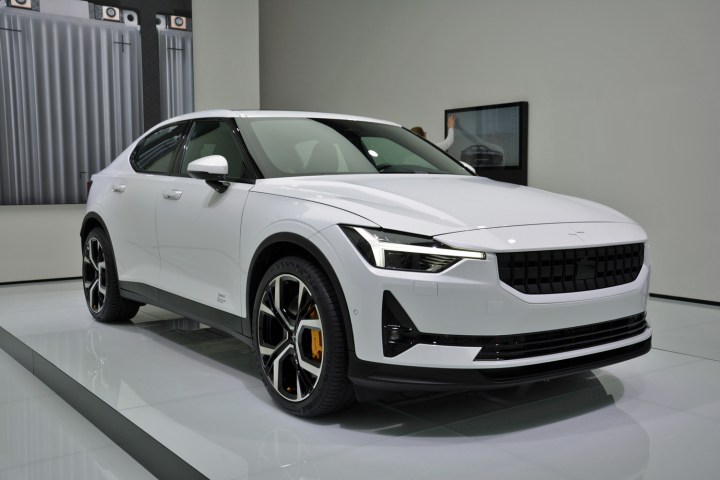
Base range: 275 miles
Base price: $63,000
Available in: 2020
The plug-in hybrid 1 is the only Polestar model you’ll ever see at a gas station. Starting with the 2, every car the Volvo-owned company releases will be electric. It’s a little bit taller than a standard sedan, it almost reminds us of the short-lived S60 Cross Country, and it will compete in a segment currently dominated by the Tesla Model 3.
While 408 hp sounds awesome, Digital Trends was even more impressed by the 2’s Android-powered, touchscreen-based infotainment system, which we found highly intuitive to use and feature-rich. The in-car version of Google Assistant will appear in the 2 for the first time, and phone-as-key technology will make sharing the car as easy as sending a text message. Built in China, the Polestar 2 should arrive in America by the end of 2020.
Polestar 3

Base range: TBD
Base price: TBD
Available in: TBD
Polestar’s third model will arrive as a crossover likely called 3. Maximilian Missoni, the company’s head of design, told Digital Trends the soft-roader will borrow styling cues from the Precept concept (shown above) introduced in 2020. It will come with an evolution of the Android-powered infotainment system inaugurated by the 2.
Porsche Macan

Base range: TBD
Base price: TBD
Available in: TBD
Porsche confirmed the second-gen Macan will be all-electric, all the time. It won’t be available with a four- or a six-cylinder engine. The company stopped short of revealing full technical details, so we don’t know how many miles the electric SUV will be able to cover on a single charge or how quick it will be. It also pointed out the current-generation model (pictured) will stay in production for buyers not interested in an electric car.
Porsche Taycan Cross Turismo

Base range: TBD
Base price: TBD
Available in: 2020
The Cross Turismo is a taller, more spacious evolution of the Porsche Taycan that stands out with SUV-like design cues. Porsche isn’t known for making station wagons, though it currently offers a long-roof variant of the Panamera, but its product planners sensed a demand for a more road trip-friendly alternative to the Taycan sedan. The Mission E Cross Turismo concept (pictured), unveiled in 2018, accurately previews what the firm’s second EV will look like.
Rimac C_Two

Base range: 400 miles
Base price: $2 million
Available in: 2020
Croatia-based Rimac is on a quest to electrify the supercar segment, and it’s closer to achieving this goal than anyone else. Powered by four electric motors, the gorgeous C_Two puts 1,914 hp and 1,696 pound-feet of torque under the driver’s right foot. That’s enough for a 1.85-second sprint from zero to 60mph, a figure that, if achieved in real life, would make it the quickest production car in the world. We have bad news if it sounds like something you’d want to put in your garage: The 150-car production run is entirely sold out despite a $2 million price.
Rimac’s unique approach to performance has turned more than a few heads in the automotive industry. Hyundai invested $90 million into the Croatian firm to launch the development of an electric sports car, and Porsche purchased a 15.5% stake in the firm to help it electrify its range of models. While Rimac isn’t a household name in 2020, we’re betting it’s a company every enthusiast will be familiar with by 2025.
Rivian R1T
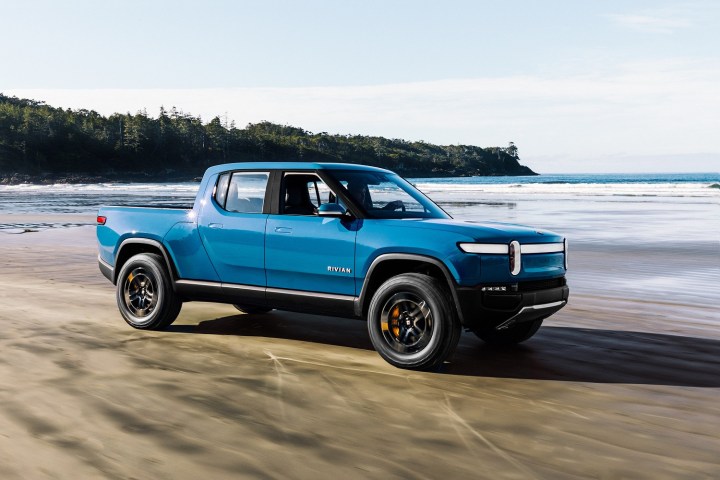
Base range: 230 miles
Base price: $69,000
Available in: 2021
Once an obscure startup with a murky future, Rivian has become one of the automotive industry’s most cherished up-and-comers. Its plan to electrify the off-roader segment earned it a significant investment from Amazon and a lucrative deal to build electric delivery vans for the retail giant. In the meantime, it plans to start manufacturing the R1T, its first series-produced model, by early 2021 in a former Mitsubishi factory located in Illinois.
The R1T lineup will include several battery options that deliver between 230 and 400 miles of range and anywhere between 402 and 745 hp depending on the configuration. Those are numbers we normally associate with performance cars, not pickup trucks, but speed is a must to compete against the Tesla Cybertruck.
That’s just the tip of the iceberg. The R1T will double as a mobile power supply, so you’ll be able to run power tools off the grid, and it will have the ability to perform a tank turn. Rivian also developed a kitchen that fits into the wide storage compartment integrated into the space right above the truck’s chassis. It slides out to reveal drawers for pots, pans, and other utensils, a small countertop, and an electric stove that draws electricity from the battery pack.
Rivian R1S

Base range: 240 miles
Base price: $72,500
Available in: 2021
Rivian’s R1S is nearly identical to the R1T under the sheet metal. Both models are built on the same skateboard platform, they’re available with the same battery options, and they both offer four electric motors in their most expensive configuration. The main difference is the body: The R1S is an SUV, while the R1T is a pickup truck.
Subaru EV

Base range: TBD
Base price: TBD
Available in: TBD
Subaru is joining forces with Toyota to develop its first series-produced electric car. The project is at the embryonic stage of development, but we already know it will take the form of a crossover that will be roughly as big as a RAV4. All-wheel drive is a given — the configuration has been one of the company’s selling points for decades — but whether that means two or four motors remains to be seen. The yet-unnamed model is scheduled to land in showrooms by 2025, and Subaru plans to kick gasoline-burning engines out of its range by the middle of the 2030s.
Tesla city car
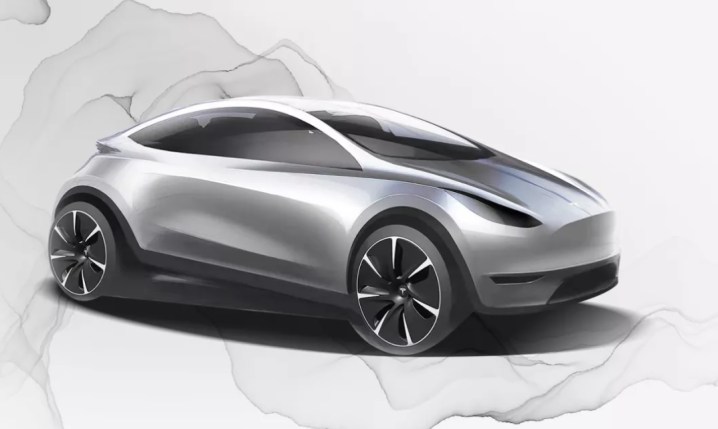
Base range: TBD
Base price: TBD
Available in: TBD
In 2020, Tesla began recruiting engineers and designers to staff a planned research and development center located in China. It explained it ultimately wants to create what it referred to as a Chinese-style vehicle and released a sketch of what looks like its smallest car to date to illustrate what it has in mind. Details like when the yet-unnamed model will break cover, how much it will cost, and whether it will be sold in the United States remain under wraps.
The firm announced plans to make a $25,000 car by 2023, however. Could it be a city-friendly hatchback?
Tesla Cybertruck

Base range: 250 miles
Base price: $39,000
Available in: Late 2021
The pyramid-shaped Tesla Cybertruck left no one indifferent when it made its debut in late 2019. While it’s certainly not to everyone’s taste, company co-founder and CEO Elon Musk confirmed more than 250,000 buyers had put down a $100 deposit to reserve the model less than a month after its unveiling. The lineup includes three variants with anywhere between 250 and 500 miles of driving range, depending on the configuration. It’s tempting to compare the Cybertruck to the Ford F-150, America’s best-selling vehicle, but Tesla hinted it’s a better match for bigger pickups.
Deliveries are scheduled to start in late 2021, so you’ve got time to save up for one. Unless you’re Musk, who has already been spotted driving a Cybertruck prototype through downtown Los Angeles.
Tesla Model S Plaid
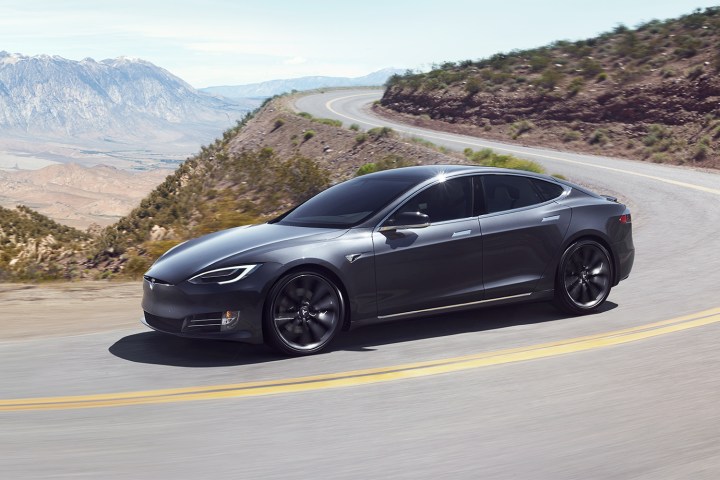
Base range: 520 miles
Base price: $140,000
Available in: Late 2021
Tesla doesn’t mess around when it comes to performance. Announced in September 2020, the range-topping Plaid variant of the Model S will go on sale in late 2021 with about 520 miles of range, a mind-numbingly quick zero-to-60-mph time of under two seconds, and a base price of $140,000. Tesla pegged its total output at about 1,100 hp.
Tesla Roadster

Base range: 620 miles
Base price: $200,000
Available in: 2020
Tesla credits the original, Lotus-based Roadster for putting its name on the map. It stopped building the drop-top to focus on more mainstream cars, like the Model S and the Model 3, but it has always pledged to return to the sports car segment with a vengeance. Elon Musk candidly explained his goal is “just to give a hardcore smackdown to gasoline cars.” On paper, the next Roadster’s mighty electric powertrain looks like it’s up to the task.
The numbers are jaw-dropping. The mammoth, 200 kWh lithium-ion battery pack sends the Roadster from zero to 60mph in 1.9 seconds, while delivering up to 620 miles of driving range. If that’s not good enough, remember Musk promised to add a Space X-sourced cold gas thruster system that will allow the convertible to hover over the road. Deliveries were tentatively scheduled to start in 2020, but Tesla has been unusually quiet about it.
Volkswagen ID.4

Base range: 250 miles
Base price: $40,000
Available in: Late 2020
The ID Crozz concept Volkswagen unveiled during the 2017 Shanghai Auto Show spawned a crossover called ID.4, a name that positions it above the Golf-sized ID.3 hatchback available in Europe and other global markets. It’s built on Volkswagen’s highly flexible MEB architecture, so it was developed as an EV from the get-go, and it’s packed with state-of-the-art connectivity features that are very smartphone-like in terms of graphics and layout. It’s about as spacious inside as a Tiguan in spite of a smaller footprint; That’s the advantage of an electric powertrain.
Volkswagen made the ID.4 rear-engined and rear-wheel drive in its standard configuration, though an all-wheel drive variant with two electric motors will be available a little bit later in the production run. It puts 302 hp under the driver’s right foot in its most powerful configuration, and it offers up to 250 miles of driving range.
Volkswagen ID.Buggy

Base range: TBD
Base price: TBD
Available in: TBD
Officially, Volkswagen built the ID.Buggy concept to show the flexibility of the MEB platform it developed specifically to underpin electric cars. It illustrates the fun side of the German company’s imminent electrification offensive. It looks like an unlikely candidate for production, but Volkswagen told Digital Trends it could happen if the numbers add up. Other, more volume-oriented cars will take precedence over the Buggy.
It will be well worth the wait if it ends up reaching the market. Digital Trends drove the one-off concept in sunny California, and it turned more heads than a pink Ferrari belching a foot of blame out of its exhaust.
Volkswagen ID.Buzz

Base range: TBD
Base price: TBD
Available in: TBD
It comes in an extended version of the MEB, as mentioned on the above platform. This Volkswagen offers two electric motors that deliver 369 hp, allowing it to perform much quicker than some may think. Some less powerful models still join this range. Recently, the brand has declared that the vacation-friendly Buzz will spawn a cargo van. Both versions will have semi-autonomous driving capabilities, which Volkswagon has plans to demonstrate soon. Be on the lookout at the 2022 FIFA World Cup in Qatar, as this is where the company will be unveiling the V.W. Buzz for the first time. Until then, we’ll keep our eyes peeled on Buzz’s progress and all the neat features it has to offer.
Volvo XC40 Recharge

Base range: TBD
Base price: TBD
Available in: TB
Volvo’s first series-produced electric car is an upgrade of the XC40, the company’s entry-level model. This model combines all the features we love about the XC40, such as a sleek design and uniform interior, and wraps it around a battery-powered drivetrain. This drivetrain includes two electric motors on each axle, which unite to deliver 402 hp, with the range clocking in well over 200 miles. Fortunately, this advanced technology can charge the battery to 80% within 40 minutes. Overall, this model is shockingly efficient and will surely benefit motorists who need a battery boost. Volvo will release more details when the Recharge is officially introduced to the public. Currently, we do not know what date that will be.
The good news is, potential buyers can reserve one of these models with a simple deposit of $1000.
It’s important to remember that electric vehicles are still relatively new to the market. We’ve certainly come a long way in the past few years, but there is still a long way to go. However, the future of EVs is a bright one. Volvo believes that EVs will be found in every driveway in a short amount of time. Even some of the top pre-selling models are still concepts at the moment. There are many options available to you if you’re able to pay for a deposit. You’re fortunate if you have the opportunity to test out a concept. Try reaching out to auto companies near you. You’ll never know if you don’t try.
Editors' Recommendations
- Here’s how EVs charge as they drive on a stretch of Michigan road
- Mercedes G580 electrifies an off-road icon
- The 10 best car battery brands in 2024
- Best electric car charger deals: $100 off home charging stations
- 2025 Mercedes-Benz EQS sedan gets new face, bigger battery



